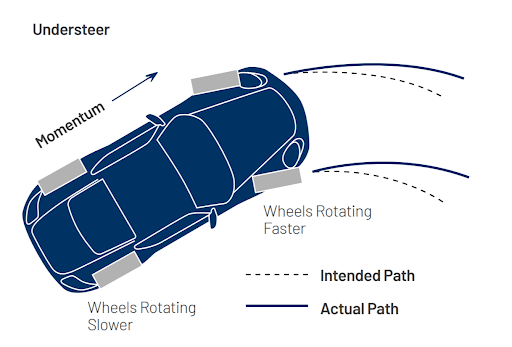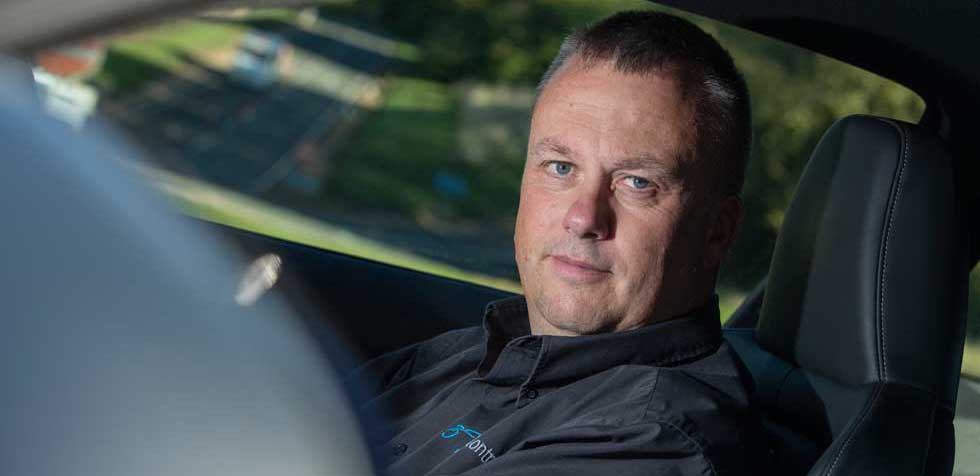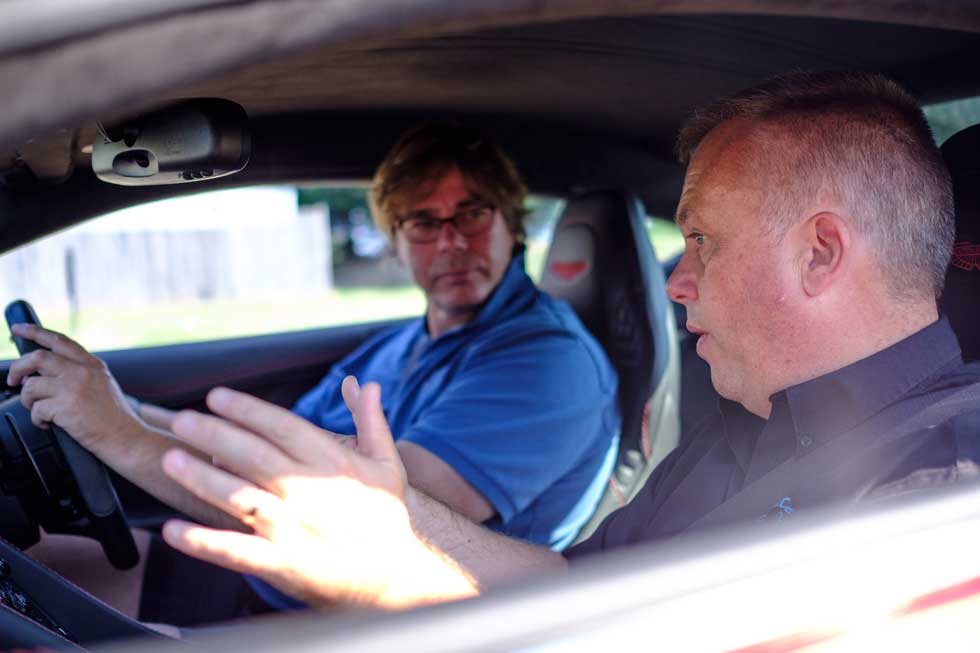Whilst all sports car drivers are familiar with the terms understeer and oversteer, there appear to be many misconceptions as to quite what each term means or just what causes such issues.
What is understeer?
Understeer is when a vehicle turns less than the angle requested through steering input, i.e. the front tyres struggle for traction, causing the vehicle to under-rotate and push wide through a turn.

What causes understeer?
Understeer happens as a direct result of driver input. Turning the steering wheel harshly, abruptly or just too much for the vehicle’s speed versus the available grip will exceed the front tyres’ traction, forcing the nose of the car to slide wide across the road surface in understeer. Cold or wet conditions make this all the more likely of course, whilst a lack of weight over the front tyres when smoothly accelerating too much too early mid-corner also triggers the problem.
Symptoms of understeer include:
- Tyre screeching from the front wheels
- Drifting towards the outside of a bend
- Steering that feels light
- Vibration through the steering wheel
How to correct understeer
We know that understeer is a result of the front tyres losing adhesion to the road surface. We know this is caused by either excessive acceleration, steering, or speed for the steering angle required and available grip. To regain control, it is necessary to first remove (or at least reduce) the cause.
Easing off the throttle (and braking if necessary), when understeer occurs is instinctive and helps restore grip thanks to the reduction in speed and forward weight transfer pressing the front tyres on to the road. Unfortunately, it is also an instinctive reaction to wind on more and more steering lock to try and force the car to turn. This merely exaggerates the problem as increasing the steering input when front end grip is lost merely increases the slip angle, taking the tyres further from the point where they will regain traction. Therefore, though counter-intuitive, briefly release a little of the steering input at the same time as easing off the throttle. Doing so enables the tyres to regain grip sooner and therefore regain control of the car. This is one of those occasions when less means more.
There are also some simple adjustments that can be made to the car to reduce the likelihood of understeering. These include:
- Reducing tyre pressure or using softer tyres at the front of the car.
- Softening the anti-roll bar or front springs.
- If aerodynamics are fitted, increasing the front downforce.
What is oversteer?
Oversteer is when a vehicle rotates more than the angle requested by the driver through steering input, most commonly understood as the rear tyres sliding sideways in a bid to overtake the front tyres.

What causes oversteer?
Oversteer is a result of one of three driver actions:
- Applying excessive, sudden throttle in a powerful gear whilst steering (in a rear wheel drive car).
- Lifting off the throttle suddenly whilst steering
- Excessive ‘trail braking’
In the first instance, the harsh application of too much power can overcome the rear tyres’ traction and create wheelspin, with the lateral inertia from the steering input causing the spinning tyres to slide sideways.
In the last two instances, excessive forward weight transfer leaves the now light rear tyres with little grip, resulting in an oversteer slide when the heavily laden front tyres turn into a bend. This is known as ‘lift-off’ oversteer and can affect all cars, whether with rear, front or all-wheel drive.
Symptoms of oversteer include:
- The car begins to spin so that the driver faces the inside of the corner
- The back of the car becomes “light” and unsteady due to lack of grip
How to correct oversteer
Firstly, we need to understand what that cause is:
- Is there too much power going through the rear tyres overwhelming their grip level?
- Is there excessive forward weight transfer entering a bend, the transition leaving the rear tyres with insufficient grip on the road (lift-off oversteer)
As the causes are different, so too are the techniques to recover the situation.
There is at least a common theme with the steering. As was the case in correcting an understeer, turning towards the slide assists recovery. In the heat of the moment, however, it is not uncommon for drivers to forget which way to turn, either steering in the wrong direction or simply freezing and not reacting at all; whilst some initially turn in the correct direction to begin with, only to change their mind when the car doesn’t react instantly.
Top Driving Tip:
Your hands on the steering wheel should normally follow where your eyes lead, so keep looking in the direction in which you want to go.
Quick hands are needed to apply counter-steering and correct oversteer before the angle of drift becomes too large. React too slowly and it will be a struggle to recover control. With the counter-steering set, allow the vehicle time to respond if on a slippery surface. The time this will take depends on the car, the tyres and the grip level.
Beware the common mistake of over-correcting with the steering, as this creates a pendulum effect as weight transfers side-to-side and develops kinetic energy; the secondary skid being all the harder to catch.
Correction if oversteer has been caused by too much power
To correct a slide caused by power, release the throttle smoothly to remove the cause. If the angle of drift is really severe, dipping the clutch to disengage all torque from the rear wheels can prevent the car being pushed all the way around in a spin.
If the oversteer has been caused by quickly releasing power
In a lift-off oversteer situation, where the lack of rear-end weight is the problem, smooth acceleration transfers weight to where it is needed to restore grip. This is very counter-intuitive, and requires ample space to complete safely.
Where space is limited, or when a slow or inappropriate reaction has allowed oversteer to reach a point of no return and a spin is unavoidable, all that is left to do is immediately dip the clutch (assuming a manual transmission) and brake as hard as you can to a stop.
Wrapping up
Pretty much all modern cars are deliberately engineered to understeer before they oversteer. This is due to understeer being relatively easy and largely intuitive to control and correct, hence safer, whereas oversteer requires considerably more skill; not to mention very quick reactions. Another reason for cars being engineered to understeer is that, if the worst does happen and control is lost, it’s generally safer to crash head-on than sideways; benefitting from larger airbags and significant impact absorbing crumple zones in the vehicle, plus we are physically better able to withstand a frontal impact than one from the side. The downside to this tendency toward understeer for the high performance driver is diminished dynamic handling and enjoyment at the edge of the grip envelope, but this can be readily compensated for by adapting our driving style; and is something frequently covered in Dynamic Driving Masterclass courses here at Total Car Control.
High Performance Principles
Download your FREE e-book and immerse yourself in knowledge that you can start applying to your driving right away

Crammed with straight-talking tips and techniques to make your driving all the more engaging, more enjoyable, and more rewarding. Our e-book was borne of a desire to freely share key advice that will give you at least a taste of what you can expect to gain from coaching with us.
Please be assured that your details are safe with us: we hate spam as much as you do, and will never share your information with anyone.





